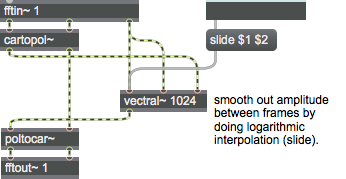vectral~
Description
Use the vectral~ object to filter frame-based signal data such as the output of the fft~ object.
Examples

Discussion
It may operate in one of the following modes:
- linear ramp across up/down frames to the new value
- logarithmic movement to new value
- limits the change in samples to be in the given range
Arguments
vector-size [int]
The argument is the vector size for the operation. It defaults to 512, but should be set appropriately for the size of the vectors you feed into the vectral~ object.
Attributes
Common Box Attributes
annotation [symbol]
Sets the text that will be displayed in the Clue window when the user moves the mouse over the object.
background [int] (default: 0)
Adds or removes the object from the patcher's background layer. adds the object to the background layer, removes it. Objects in the background layer are shown behind all objects in the default foreground layer.
color [4 floats]
Sets the color for the object box outline.
fontface [int]
Sets the type style used by the object. The options are:
plain
bold
italic
bold italic
Possible values:
0 = 'regular'
1 = 'bold'
2 = 'italic'
3 = 'bold italic'
fontname [symbol]
Sets the object's font.
fontsize [float]
Sets the object's font size (in points).
Possible values:
'8'
'9'
'10'
'11'
'12'
'13'
'14'
'16'
'18'
'20'
'24'
'30'
'36'
'48'
'64'
'72'
hidden [int] (default: 0)
Toggles whether an object is hidden when the patcher is locked.
hint [symbol]
Sets the text that will be displayed in as a pop-up hint when the user moves the mouse over the object in a locked patcher.
ignoreclick [int] (default: 0)
Toggles whether an object ignores mouse clicks in a locked patcher.
jspainterfile [symbol]
JS Painter File
patching_rect [4 floats] (default: 0. 0. 100. 0.)
Sets the position and size of the object in the patcher window.
position [2 floats]
Sets the object's x and y position in both patching and presentation modes (if the object belongs to its patcher's presentation), leaving its size unchanged.
presentation [int] (default: 0)
Sets whether an object belongs to the patcher's presentation.
presentation_rect [4 floats] (default: 0. 0. 0. 0.)
Sets the x and y position and width and height of the object in the patcher's presentation, leaving its patching position unchanged.
rect [4 floats]
Sets the x and y position and width and height of the object in both patching and presentation modes (if the object belongs to its patcher's presentation).
size [2 floats]
Sets the object's width and height in both patching and presentation modes (if the object belongs to its patcher's presentation), leaving its position unchanged.
textcolor [4 floats]
Sets the color for the object's text in RGBA format.
textjustification [int]
Sets the justification for the object's text.
Possible values:
0 = 'left'
1 = 'center'
2 = 'right'
varname [symbol]
Sets the patcher's scripting name, which can be used to address the object by name in pattr, scripting messages to thispatcher, and the js object.
Messages
clear
deltaclip
Arguments
high-limit [float]
rampsmooth
Arguments
signal
In middle inlet: A sync signal received in the middle inlet is used to synchronize the input index of the vector being processed. The sync signal will typically be in the range 0 to n-1 (where n is the size of the vector). If the left and middle inlets are "out-of-sync", the incoming vector's bins will shift by the difference between the two signals.
In right inlet: Signal data to be filtered. This will usually be frequency-domain information such as the output of an fft~ or fftin~ object.
size
Arguments
slide
Arguments
Output
signal
A smoothed version of the signal input into the right inlet, according to the parameters given to the vectral~ object.
See Also
| Name | Description |
|---|---|
| Spectral Processing | Spectral Processing |
| cartopol | Convert cartesian to polar coordinates |
| cartopol~ | Signal Cartesian to Polar coordinate conversion |
| deltaclip~ | Limit changes in signal amplitude |
| fft~ | Fast Fourier transform |
| fftin~ | Input for a patcher loaded by pfft~ |
| fftinfo~ | Report information about a patcher loaded by pfft~ |
| fftout~ | Output for a patcher loaded by pfft~ |
| frameaccum~ | Compute "running phase" of successive phase deviation frames |
| framedelta~ | Compute phase deviation between successive FFT frames |
| ifft~ | Inverse fast Fourier transform |
| pfft~ | Spectral processing manager for patchers |
| poltocar | Convert polar to cartesian coordinates |
| poltocar~ | Signal Polar to Cartesian coordinate conversion |
| rampsmooth~ | Smooth an incoming signal |
| slide~ | Filter a signal logarithmically |
| MSP Analysis Tutorial 4: Signal Processing with pfft~ | MSP Analysis Tutorial 4: Signal Processing with pfft~ |